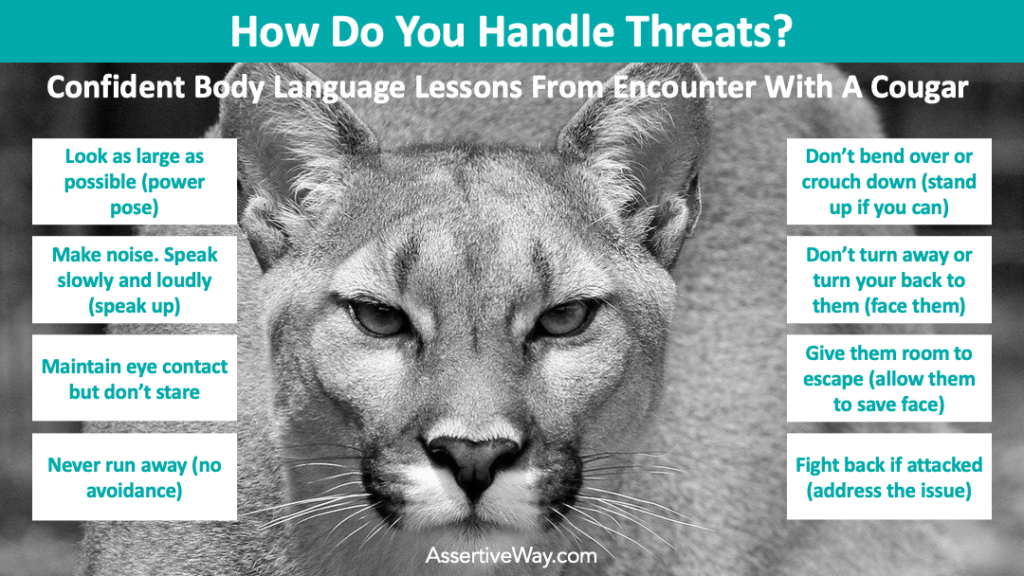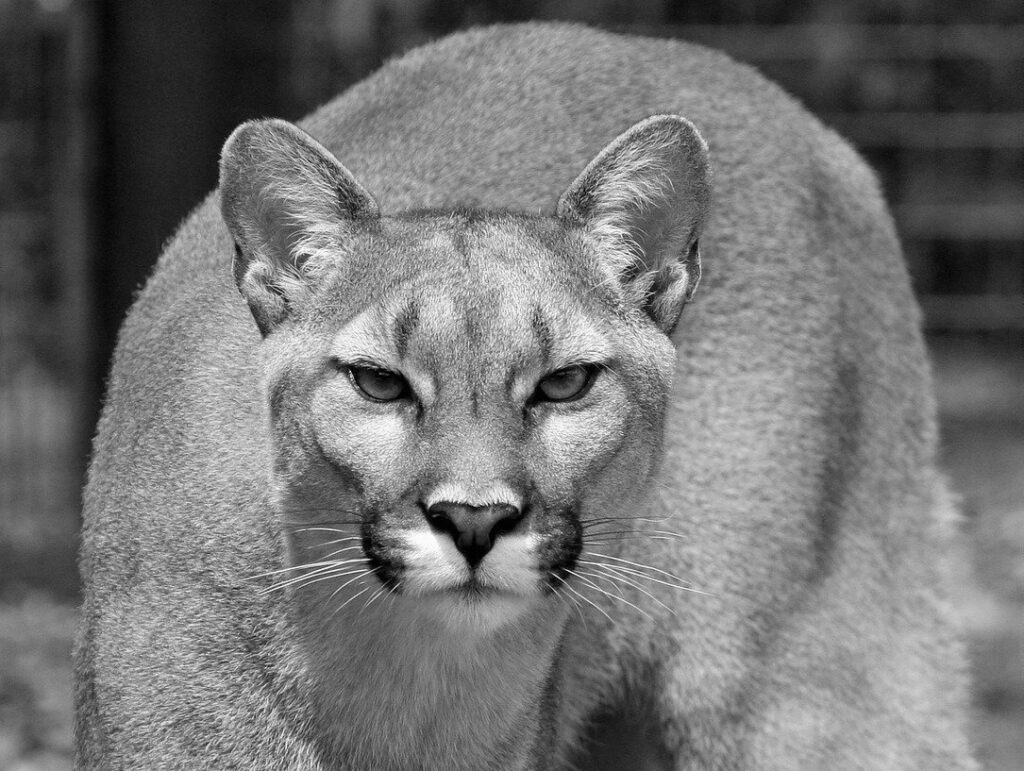Body language tips when fight or flight survival instincts happen
We included many formats below to suit your preferred information style: video, audio, article, or infographic. Enjoy 😊
By Assertive Way
Key Takeaways
- When in threat, do you take flight or fight mode?
- Like cougars, we are constantly assessing our power compared to others through our body language.
- Keep your power: keep eye contact, don't turn away and expand your body language.
- Learn how to communicate with confidence with these free resources here.
Sign up for our Weekly Newsletter “Nice With Limits” for tips and inspiration for confidence at work and to boost your career!
We take your email seriously and will never sell or share it.
My First Encounter With A Mountain Lion
My first encounter with a mountain lion was an unforgettable moment. It was unexpected, scary, and thrilling! Mountain lions are also called couger, puma, panther, or catamount.
But I made 3 big mistakes that taught me valuable lessons.
I was alone. It was dusk when mountain lions are most active. The lion and I met as we walked towards each other on the same sidewalk, one house away from each other. It saw me and it walked inside the driveway of a house.
At first, I thought it was a large coyote, so I crossed the street to walk past it. But as soon as I crossed that driveway, it was walking out of it and stopped. It gazed at me.
It was assessing if I was threat, prey, or an equal.
If a mountain lion is less than 50 yards away and is staring intensely at you, an attack may occur at any time. I was 7 yards away and it was staring at me intensely.
I knew this was potentially a life-threatening emergency. The wrong move could be very costly. I had not previously researched how to deal with mountain lion encounters. I had to make very quick decisions on my own. I didn’t have time to consult google or a friend on what to do. I had seconds. My every move was being watched closely.
My heart started to race. My senses became sharper. All I could see was the lion’s face. I felt really tense.
It was assessing if I was threat, prey, or an equal.
3 Big Mistakes
In that encounter with the mountain lion, I made 3 big mistakes:
- I broke eye contact after a few seconds.
- I turned my back towards it as I slowly moved away.
- I didn’t make any noise or expand by body language.
Luckily, I did one important thing right: I didn’t run. Running would be a clear sign I was a prey.
In panic and danger, people’s survival instinct will make them take flight or fight mode depending on how much power they feel in that situation. I instinctively took on a flight mode. I was passive. Weak. I acted like a prey. I need to learn to keep my power when in fear.
Humans are not that different. We are constantly trying to assess our power compared to others through our body language confidence.
Learn how to communicate with confidence with these free resources here.
In panic and danger, people’s survival instinct will make them take flight or fight mode depending on how much power they feel in that situation.
What To Do If You Encounter A Threat
According to mountainlion.com, this is what you should do if you meet a mountain lion, and how it applies to everyday body language behavior when dealing with other people in a tense situation.
Look as large as possible.
Go big in a situation where you want to look more confident and powerful. You can do that by standing up instead of sitting down, improving your posture, opening your arms, and placing your feet shoulder width apart.
Make noise. Speak slowly and loudly to discourage their hunting instincts.
You have something most other animals don’t: a powerful voice machine. Speak up When silent you’ll either go unnoticed or be perceived as uninterested, lacking confidence, or lower ranking. When you speak too fast or too softly you could be seen as nervous and lacking confidence. On the other hand, speaking slowly and loudly conveys assurance, strength, and power.
Maintain eye contact.
Your eye contact is everything. Look them to display confidence but don’t stare fixated at a mountain lion because that signals you’re provoking them and up for a fight.
Insecure people will turn their eyes down or away. For example, don’t look away when you meet someone, or someone gives you negative feedback, compliments, or criticizes you. Did you know that bosses tend to make more eye contact with their higher performing employees, according to the Journal of nonverbal behavior, 2010?
Never run away.
Avoidance from hard but important conversations or situations is a sign of weakness. If you’re going to avoid it, be intentional. First address it and say that you’d rather discuss it later. Be open and direct about your intention.
Don’t bend over or crouch down.
Keep a positive and confident posture as you speak to others.
Don’t turn away or turn your back to them.
Lions like to attack silently from the victim’s rear because it is a weaker position. In the same way, when your body and feet face away or diagonally out from the person you’re interacting with, you may signal discomfort and avoidance.
Slowly create distance.
If you have a problem with someone or a situation, create healthy boundaries.
Give them room to escape.
If they feel cornered or that you want to challenge them by approaching them, they may behave aggressively to protect themselves. In the same way, give people the opportunity to save face and to take some time off if they’re flustered.
Fight back if attacked.
If someone treats you without respect, then speak up. If something bothers you then address it. Don’t let it go unnoticed, otherwise it may happen again or even get worse.
Mountain lions enjoy hunting deer and elk. They rarely attack humans. When attacks do happen, it is usually because people react with prey-like behavior.
Remember to keep your power: maintain eye contact, don’t turn away and expand your body language.
Sign up for our Weekly Newsletter “Nice With Limits” for tips and inspiration for confidence at work and to boost your career!
We take your email seriously and will never sell or share it.

Summary
Here are body language confidence lessons from interacting a cougar.
- Look as large as possible (power pose).
- Make noise. Speak slowly and loudly to discourage their hunting instincts (speak up).
- Maintain eye contact but don’t stare (same).
- Never run away (no avoidance).
- Don’t bend over or crouch down (stand up if you can).
- Don’t turn away or turn your back to them (face them).
- Slowly create distance (have boundaries).
- Give them room to escape (allow them to save face).
- Fight back if attacked (address the issue).
“Lions are born knowing they are predators. Antelopes understand they are the prey. Humans are one of the few creatures on Earth given the choice.” – Patrick H.T. Doyle

What scary animals have you ran in to and how did you react? Where you surprised by your reaction?